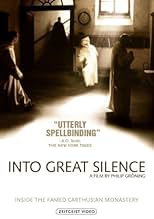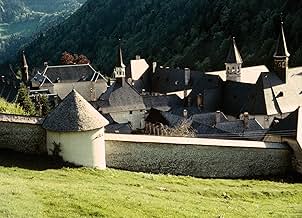IMDb रेटिंग
7.3/10
2.6 हज़ार
आपकी रेटिंग
अपनी भाषा में प्लॉट जोड़ेंAn examination of life inside the Grande Chartreuse, the head monastery of the reclusive Carthusian Order in France.An examination of life inside the Grande Chartreuse, the head monastery of the reclusive Carthusian Order in France.An examination of life inside the Grande Chartreuse, the head monastery of the reclusive Carthusian Order in France.
- निर्देशक
- लेखक
- पुरस्कार
- 5 जीत और कुल 14 नामांकन
फ़ीचर्ड समीक्षाएं
This almost silent three hour documentary tracks the daily lives of Carthusian monks living at the Chartreuse Monastery in the French Alps, as they live in a way that seems to be in such contrast with the modern world. It's a fascinating movie if you are able to get into the slow rhythm of the film (if you are still in the movie theater after an hour, you will probably made it to the third hour). By the same token, it would be almost impossible to see it in your house on DVD, since there are so many possible distractions that would make you want to stop the film. Remarkably, given that European filmmakers tend to be among the most secular people in the world, the movie is also surprisingly respectful of the choices made by the monks in living in this particular way.
I've often pondered which sense would I rather lose: sight or hearing. I had decided sight would be the one to live without since music has the power to make me weep (often). But "Die Große Stille" has made me rethink all of that. It's a pointless game anyway, but I reexamined the importance of sound in my life versus the magnificent, ravishing images put forth in this film.
Like the works of Frederick Wiseman, it's less a work of cinema than a window that Gröning offers. We watch seemingly arbitrary action both mundane and ecstatic. We're not "told" who these people are as individuals nor why they have chosen to wall themselves off from the world's joy and suffering. But as we watch, the pace of the film is slowed so that we enter this world and test our own thoughts about human contact as well as faith. But only if you're so inclined. There's no proselytizing.
At one point late in the film one monk chides the world for living without God, and you immediately think, "How would YOU know?" And immediately we see the value of silence. In silence we don't argue or plead, complain or preach. We simply live with our thoughts, and here the brothers seem very comfortable with whatever it is they are thinking.
Through repetition and ceremony, we enter the serenity these men have found. And while there's beauty in the physical aspects of both the natural world in its changing seasons as well as the cloistered setting, it's the tranquil beauty of faces that rivet. We meet them as individuals only in a series of live portraits where their eyes stare into the lens, through the camera, and into our souls. If I didn't have my sight, I would have missed that and been lesser for it.
For me, this was an amazing experience. But for others in the theater it was tough evidenced by squirming and the occasional snore. Surprisingly, it was the younger members of the audience who seemed most entranced.
Like the works of Frederick Wiseman, it's less a work of cinema than a window that Gröning offers. We watch seemingly arbitrary action both mundane and ecstatic. We're not "told" who these people are as individuals nor why they have chosen to wall themselves off from the world's joy and suffering. But as we watch, the pace of the film is slowed so that we enter this world and test our own thoughts about human contact as well as faith. But only if you're so inclined. There's no proselytizing.
At one point late in the film one monk chides the world for living without God, and you immediately think, "How would YOU know?" And immediately we see the value of silence. In silence we don't argue or plead, complain or preach. We simply live with our thoughts, and here the brothers seem very comfortable with whatever it is they are thinking.
Through repetition and ceremony, we enter the serenity these men have found. And while there's beauty in the physical aspects of both the natural world in its changing seasons as well as the cloistered setting, it's the tranquil beauty of faces that rivet. We meet them as individuals only in a series of live portraits where their eyes stare into the lens, through the camera, and into our souls. If I didn't have my sight, I would have missed that and been lesser for it.
For me, this was an amazing experience. But for others in the theater it was tough evidenced by squirming and the occasional snore. Surprisingly, it was the younger members of the audience who seemed most entranced.
If you begin watching this film expecting an explanatory documentary about monastic life in La Grande Chartreuse, you may soon become bored and fed up. If you begin watching this film expecting to be taken into the monastic way of life, you will soon find yourself there. The movie takes the pace of the slow, quiet atmosphere of the monastery. Long periods of silence broken by the occasional creak of floorboards or chanting or bells, and very little dialogue. It is like each shot is a photograph. A moving photograph.
It is not entirely what one expects, however. Keep an eye out for the odd object seemingly out of place: the highlighter, the keyboard, the laptop; the odd conversation on a monk's departure for Seoul, South Korea; the shot of monks sliding down a snowy bank on their bums.
I wanted more explanation - how the individuals chose this way of life; how they sustain their community; what contact they have with secular people. But it is not that kind of documentary. As long as you're prepared for that, it is a film worth watching.
It is not entirely what one expects, however. Keep an eye out for the odd object seemingly out of place: the highlighter, the keyboard, the laptop; the odd conversation on a monk's departure for Seoul, South Korea; the shot of monks sliding down a snowy bank on their bums.
I wanted more explanation - how the individuals chose this way of life; how they sustain their community; what contact they have with secular people. But it is not that kind of documentary. As long as you're prepared for that, it is a film worth watching.
Very beautiful and original pictures in this movie. You can also enjoy such simple things as the sound of the snow falling or a scissors cutting a wool cloth...
In my opinion, the movie is not repetitious. I think the intention of the director is to introduce you in the monks' everyday life, and therefore you have to understand the routine and discipline they are attached to. It is just the silence that illuminates these people.
And I didn't know there were such really sweet monks in the catholic church!
At the cinema everybody were staying till the very end, although I have to say that someone was sleeping behind me ;-)
In my opinion, the movie is not repetitious. I think the intention of the director is to introduce you in the monks' everyday life, and therefore you have to understand the routine and discipline they are attached to. It is just the silence that illuminates these people.
And I didn't know there were such really sweet monks in the catholic church!
At the cinema everybody were staying till the very end, although I have to say that someone was sleeping behind me ;-)
I am glad that I saw Die Grosse Stille. It was deeply touching. The silence somehow allowed one to witness the deeply private lives and experiences of these meditators. I saw this film a few days before. My girlfriend wanted dearly to see it but I had been put off by some critical comments posted on these pages. I am glad that I overcame my doubts. The views of both the inside of the monastery and the outer surroundings enhanced the feelings of the 'separateness'of the mountainside retreat. I have been a meditator for quite a few years and I lived among the Tibetan communities in India for some years. There also one can find a 'Great Stillness'. Are you prepared to set aside conventional standards and expectations of a film 'experience'? If 'yes,', then I recommend this film to you.
क्या आपको पता है
- ट्रिवियाPhilip Groning (director) spent six months living in the Grande Chartreuse Monastery with the Carthusian monks. Normally, the order doesn't allow visitors within the enclosure, but after thinking, discussing, and praying about it for sixteen years, they finally agreed to allow him to make his film. Groning shot all the footage on his own, and decided early on to use no special effects: no soundtrack (other than the Carthusian chants), no artificial sound effects, no commentary, not even any artificial lighting. The only inclusion to the natural rhythm of the monastery was a modest collection of intertitular scriptures. After two-and-a-half years of editing, Groning presented his completed film. Reportedly, the monks saw the documentary and thoroughly enjoyed it.
- भाव
Blind Monk: The past, the present, these are human. In God there is no past. Solely the present prevails. And when God sees us, He always sees our entire life. And because He is an infinitely good being, He eternally seeks our well-being. Therefore there is no cause for worry in any of the things which happen to us.
- कनेक्शनFeatured in Het elfde uur: एपिसोड #15.4 (2006)
टॉप पसंद
रेटिंग देने के लिए साइन-इन करें और वैयक्तिकृत सुझावों के लिए वॉचलिस्ट करें
- How long is Into Great Silence?Alexa द्वारा संचालित
विवरण
- रिलीज़ की तारीख़
- कंट्री ऑफ़ ओरिजिन
- आधिकारिक साइटें
- भाषाएं
- इस रूप में भी जाना जाता है
- Into Great Silence
- फ़िल्माने की जगहें
- उत्पादन कंपनियां
- IMDbPro पर और कंपनी क्रेडिट देखें
बॉक्स ऑफ़िस
- US और कनाडा में सकल
- $7,90,452
- US और कनाडा में पहले सप्ताह में कुल कमाई
- $11,355
- 4 मार्च 2007
- दुनिया भर में सकल
- $48,86,163
- चलने की अवधि
- 2 घं 49 मि(169 min)
- रंग
- ध्वनि मिश्रण
- पक्ष अनुपात
- 1.85 : 1
इस पेज में योगदान दें
किसी बदलाव का सुझाव दें या अनुपलब्ध कॉन्टेंट जोड़ें


























